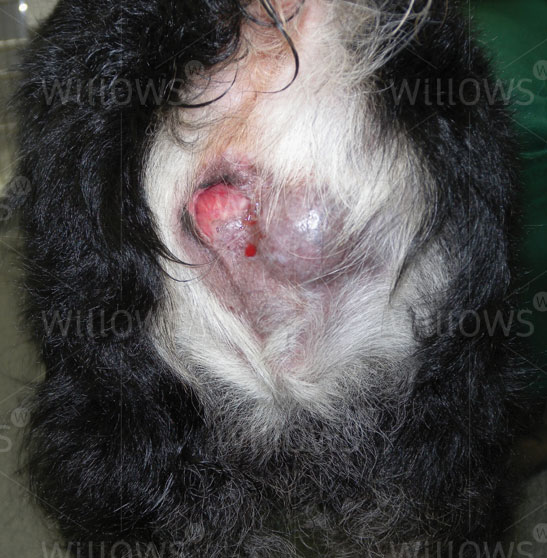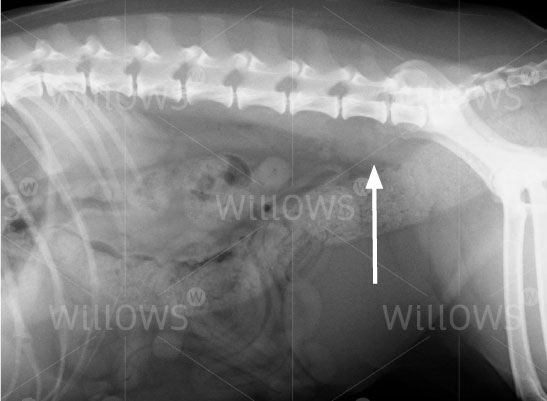Why Should I Bring my Pet to Willows for Diagnosis and Treatment of Anal Sac Tumours?
Willows is one the UKs only referral centres to have full-time Specialists in both Medical and Surgical Oncology Specialists. This, combined with a multi-disciplinary team approach to the management of pets with anal sac tumours, enables Willows to provide the best possible levels of care to our patients.
Our oncology team are fully supported by Specialists in Diagnostic Imaging, Anaesthesia, Emergency and Critical Care, Clinical Nutrition and by our dedicated Interns, Nurses and Clinical support staff who provide care 24 hours a day, 365 days of the year.
What are Anal Sac Tumours?
The anal sacs are two small glands that sit either side of the anus (back passage), under the tail. They produce a strong-smelling secretion which is emptied onto the faeces (stools).
Tumours (growths) may develop from the lining cells of these glands and are known as anal sac tumours (carcinoma of the apocrine glands of the anal sac). These tumours are relatively uncommon in dogs, representing approximately 2% of all skin tumours, and they are very rare in cats. Anal sac tumours tend to be malignant and invade into tissues outside of the anal sac, they also have the potential to spread to other areas, including the lymph nodes (‘lymph glands’) under the spine and the lungs. Between 50% and 80% of dogs have evidence of tumour spread at the time of diagnosis, even though in some of these animals the primary (original) tumour is small (less than 1cm across).

What are the signs of Anal Sac Tumours?
Anal sac tumours may be suspected or identified in the following ways:
- The tumour may be noted as an incidental finding during a routine examination, especially when an internal rectal examination is performed
- A lump or mass close to the anus is noticed or can be felt, e.g. during grooming
- A mass close to the anus causes irritation or bleeding in this area
- A large mass close to the anus or enlargement of the lymph nodes in the pelvis may cause difficulty in passing faeces and constipation
- Some tumours cause an elevation in the blood calcium level, and the clinical signs related to this abnormality (weakness, drinking more) are noticed first by the owner
An elevated blood calcium level is seen in 27% to 90% of animals with anal sac tumours. The blood calcium level tends to fall with successful treatment, and a recurrence of the high blood calcium level often indicates recurrence of the tumour
Fig 1: A large anal sac carcinoma. This patient had a high blood calcium level as a result of the tumour


How is an Anal Sac Tumour Diagnosed?
When an anal sac tumour is suspected, a rectal examination and a biopsy are performed to confirm the diagnosis. Other diagnostic tests are also performed to determine which sites of the body are affected and to identify whether the blood calcium level is elevated.
These tests include:
- Blood samples for haematology (looking at red and white blood cells) and biochemistry (looking at various factors including blood calcium levels and internal organ function)
- Urine analysis
- CT scan or X-ray examination of the chest
- CT scan, X-ray, or ultrasound examination of the abdomen
Fig 2: X-ray of a patient with mildly enlarged lymph nodes under the spine (arrow)
What Treatment Options are Available for the Treatment of Anal Sac Tumours?
The treatment of anal sac tumours has a number of aims:
Initial management of high blood calcium levels in certain patients
High blood calcium can have a number of adverse effects on the body and increases the risk when giving a general anaesthetic. The problem is treated initially with intravenous fluids (a ‘drip’) and drugs to encourage the calcium to be flushed out through the kidneys. Once the blood calcium level has been reduced with medical therapy, surgical removal of the tumour at the primary site and in the lymph nodes will prevent the calcium level rising again.
Controlling the tumour at the primary (original) site in the anal sac
This is best performed by removing the tumour surgically, although this can be difficult for large tumours in this area. Surgery can be followed by radiotherapy if not all the tumour can be removed, although radiotherapy has the potential for causing side-effects.
Controlling the tumour if it has spread to the lymph nodes
If the tumour has spread to the lymph nodes, the lymph nodes may be removed surgically, or included in the radiotherapy field, if radiotherapy is to be used as a treatment option.
Delaying or preventing tumour spread in the long term
The role of chemotherapy (anti-cancer drugs) in the treatment of anal sac tumours is not clear cut. Animals with advanced disease where the tumour has already spread have a better outcome if chemotherapy is given. However, since the tumour has the potential to spread in most cases, many cancer specialists will recommend treatment with chemotherapy to delay or prevent spread of the tumour, even in patients where spread has not yet been detected.
What can I Expect if my Pet is Treated for Anal Sac Tumours?
Anal sac tumours are malignant and have the potential to spread, so many animals are not completely cured of their tumour with treatment. However, with appropriate treatment, we can improve the quality of life for our patients for a long period of time.
The average survival time for dogs with anal sac tumours following appropriate therapy is between 12 to 40 months, patients with earlier stage disease generally have a longer survival time. Even in the presence of spread to the lymph nodes, the survival time following surgical removal of the affected lymph nodes is more than 12 months, and it is likely that this can be further improved with chemotherapy.
The outcome tends to be poorer for patients with the following:
- High blood calcium
- Large tumours, particularly greater than 10cm across
- Tumour spread to the lymph nodes and lungs.
However, even in the presence of these factors, effective therapy to improve the quality of life of such patients can still be offered.
To save this page as a PDF, click the button and make sure “Save as PDF” is selected.
Cancer Care
Find out more
To assist owners in understanding more about Cancer Care we have put together a range of information sheets to talk you through the some of the more common conditions seen and treated by our Specialists.

